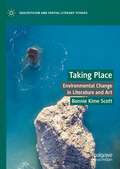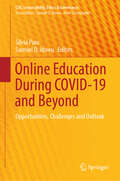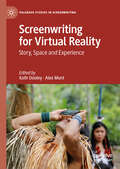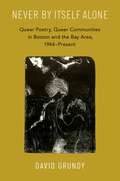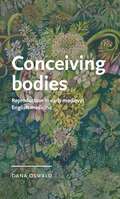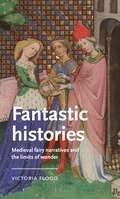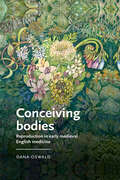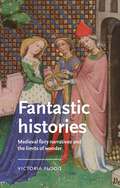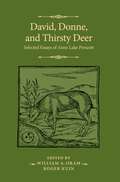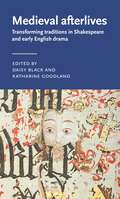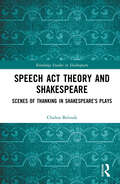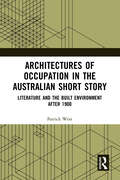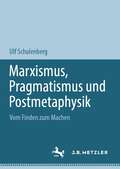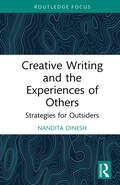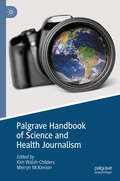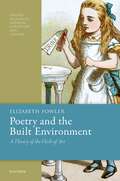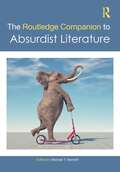- Table View
- List View
Translation and Mysticism: The Rose and the Wherefore (Routledge Studies in Literary Translation)
by Philip WilsonThis book examines how mysticism can tell us about translation and translation can tell us about mysticism, addressing the ancient but ongoing connections between the art of rendering one text in another language and the art of the ineffable.The volume represents the first sustained act of attention to the interdisciplinary crossover of these two fields, taking a Wittgensteinian approach to language, and investigates how mystics and their translators manage to write about what cannot be written about. Three questions are addressed overall: how mysticism can be used to conceptualise translation; the issues that mysticism raises for translation theory and practice; and how mystical texts have been and might be translated. Walter Benjamin’s ‘The Translator’s Task’ is considered in detail as a controversial example of dialogue. Translation examples are given in a range of languages, and six major case studies are provided, including a close reading of Exodus and an analysis of a recent radical translation of Lucretius. This book will be of interest to students and researchers in translation studies, mysticism studies, theology and literary translation, as well as practising translators.
Translation and Mysticism: The Rose and the Wherefore (Routledge Studies in Literary Translation)
by Philip WilsonThis book examines how mysticism can tell us about translation and translation can tell us about mysticism, addressing the ancient but ongoing connections between the art of rendering one text in another language and the art of the ineffable.The volume represents the first sustained act of attention to the interdisciplinary crossover of these two fields, taking a Wittgensteinian approach to language, and investigates how mystics and their translators manage to write about what cannot be written about. Three questions are addressed overall: how mysticism can be used to conceptualise translation; the issues that mysticism raises for translation theory and practice; and how mystical texts have been and might be translated. Walter Benjamin’s ‘The Translator’s Task’ is considered in detail as a controversial example of dialogue. Translation examples are given in a range of languages, and six major case studies are provided, including a close reading of Exodus and an analysis of a recent radical translation of Lucretius. This book will be of interest to students and researchers in translation studies, mysticism studies, theology and literary translation, as well as practising translators.
Taking Place: Environmental Change in Literature and Art (Geocriticism and Spatial Literary Studies)
by Bonnie Kime ScottTaking Place: Environmental Change in Literature and Art explores how works of literature and art help us to rethink the ways that we have perceived, imagined, inhabited, explored, conquered, and shared places. The book offers chapters on India, Southern Africa, Ireland, Australia, and New York City. The literary and artistic works investigated range in time from early indigenous rock art to contemporary literary representations of place. Bonnie Kime Scott participates in ongoing interdisciplinary discussions of ecocritical, feminist, postcolonial, post-humanist and place studies.
Critical Sociolinguistic Research Methods: Studying Language Issues That Matter
by Sari Pietikäinen Monica Heller Joan PujolarCritical Sociolinguistic Research Methods is a guide to conducting concrete ethnographic and discourse analytic research projects, written by top scholars for students and researchers in social science fields. Adopting a critical perspective focusing on the role of language in the construction of social difference and social inequality, the authors walk the reader through five key moments in the life of a research project: composing research questions, designing the project, doing fieldwork, performing data analysis and writing academic texts or otherwise engaging in conversation with different types of social actors about the project. These moments are illustrated by colour-coded examples from the authors’ experiences that help researchers and students follow the sequential stages of a project.Now in its second edition, this popular and original text has been revised and updated to reflect the latest developments in this field, including expanded sections on the centrality of the ethnographic gaze for the understanding of social processes, and on experiences of diversification in the communication of research results. Through the adoption of multimodal genres, authors share recent experiences of research presentations addressed to non-academic audiences, such as installations and photography, and interactive maps.Clear and highly applicable, with a detailed workbook full of practical tips and examples, this book is a great resource for graduate-level qualitative methods courses in linguistics and anthropology, as well as methods courses in the humanities and social sciences that focus on the role of language in research. It is a timely text for investigating language issues that matter and have consequences for people’s lives.
Online Education During COVID-19 and Beyond: Opportunities, Challenges and Outlook (CSR, Sustainability, Ethics & Governance)
by Samuel O. Idowu Silvia PuiuThis book aims to provide sustainable solutions for better understanding and management of online education in different parts of the world. In this context, it explores the attitudes and perceptions of stakeholders, such as students, faculty, and other actors on issues related to online education. In particular, it examines the challenges they have faced over the years when online courses were introduced due to the COVID-19 pandemic. A model is proposed that includes five variables: specific communication issues in online education, the ability of professors to offer online courses, the quality of online education, students' perceived stress during online education, and the technical requirements of online education.The book will be of interest to anyone concerned with the new and future ways of teaching and learning.Chapter “When a Phenomenon-Based University Course Went Online: Students’ Experiences and Reflections After Sauna Bathing” is available open access under a Creative Commons Attribution 4.0 International License via link.springer.com.
Screenwriting for Virtual Reality: Story, Space and Experience (Palgrave Studies in Screenwriting)
by Kath Dooley Alex MuntThis book is focused on screenwriting and development for virtual reality (VR). It explores a diverse range of creative approaches to the writing and screen development of VR stories and immersive audience experiences. Contributions from scholars and practitioners combine conceptual and practically orientated approaches for creating fictional and documentary media VR stories. The book evaluates, challenges and adapts existing screenwriting models and practices for immersive storytelling and grapples with the future of storytelling in the era of sophisticated computer visualization, AI and the online social metaverse. The book proposes new VR storytelling models, identifies altered relationships between creators, screen works and their audiences and demonstrates how interdisciplinary practices will be core to the future of screen storytelling.
Never By Itself Alone: Queer Poetry, Queer Communities in Boston and the Bay Area, 1944?Present
by David GrundyProviding an unprecedented exploration of key moments in queer literary history, Never By Itself Alone changes our sense of both the American literary and political landscapes from the late 1940s through the 21st century. Grundy presents the first comprehensive history of post-war queer writing in Boston and San Francisco, intertwining analysis of lesbian, gay, and queer writing, and insisting on the link between activism and literature. The book centers a host of underrepresented writers, especially writers of color and those with gender non-conforming identities, and challenges the Stonewall exceptionalism of queer historiography. Starting with Robert Duncan's 1944 essay, 'The Homosexual in Society', one of the first significant public defenses of homosexuality in the US, Grundy takes the reader through pioneering works by queer voices of the era, including Adrian Stanford's Black and Queer, the first published book by an out, Black gay poet in the US; the Boston collective Fag Rag and their radical reconsideration of family, private property and the State; the Combahee River Collective, whose Black Feminist analysis drew together race, class, and sexuality; the anthology This Bridge Called My Back, in which women of color spoke truth to power, together; and New Narrative writing, which audaciously mixed Marxism, porn and gossip while uniting against the New Right. Linking these works to the context which produced them, Grundy uncovers the communities formed around activism and small press publishing during this era and elevates neglected voices to narrate a history that before now has never been told in its entirety. Drawing on extensive archival research, Never By Itself Alone is a rigorous and unmatched work of both literary criticism and queer scholarship which underscores the vital importance of radical accounts of race, class, and gender in any queer studies worthy of the name.
Conceiving bodies: Reproduction in early medieval English medicine (Manchester Medieval Literature and Culture)
by Dana OswaldDespite reliance on ingredients like horse dung, Old English remedies for women’s medicine speak to contemporary reproductive concerns. Previous translators reduced the remedies to a general category of women’s medicine, but sustained examination of language reveals important distinctions: remedies for menstruation indicate social concerns about fertility, where remedies for ‘cleansing’ do not provide a clear path to conception, but rather foreclose it. Rarest of all are the remedies for childbirth, but their rarity is compounded by the practices of translators who conflate the language for women’s reproduction into an amorphous singularity. Through an original method of hysteric philology—the combining of traditional philology with contemporary feminist and medical epistemologies—this book situates itself in the historical treatment of reproductive people as both objects and subjects of medical practice, and gestures forward in time to the contemporary struggle for bodily autonomy.
Fantastic histories: Medieval fairy narratives and the limits of wonder (Manchester Medieval Literature and Culture)
by Victoria FloodFantastic Histories explores the political and cultural contexts of the entry of fairies to the historical record in twelfth century England, and the subsequent uses of fairy narratives in both insular and continental history and romance. It traces the uses of the fairy as a contested marker of historicity and fictionality in the histories of Gerald of Wales and Walter Map, the continental mirabilia of Gervase of Tilbury, and the fourteenth- and fifteenth-century French Mélusine romances and their early English reception. Working across insular and continental source material, Fantastic Histories explores the practices of history-writing, fiction-making, and the culturally determined boundaries of wonder that defined the limits of medieval history.
Conceiving bodies: Reproduction in early medieval English medicine (Manchester Medieval Literature and Culture)
by Dana OswaldDespite reliance on ingredients like horse dung, Old English remedies for women’s medicine speak to contemporary reproductive concerns. Previous translators reduced the remedies to a general category of women’s medicine, but sustained examination of language reveals important distinctions: remedies for menstruation indicate social concerns about fertility, where remedies for ‘cleansing’ do not provide a clear path to conception, but rather foreclose it. Rarest of all are the remedies for childbirth, but their rarity is compounded by the practices of translators who conflate the language for women’s reproduction into an amorphous singularity. Through an original method of hysteric philology—the combining of traditional philology with contemporary feminist and medical epistemologies—this book situates itself in the historical treatment of reproductive people as both objects and subjects of medical practice, and gestures forward in time to the contemporary struggle for bodily autonomy.
Fantastic histories: Medieval fairy narratives and the limits of wonder (Manchester Medieval Literature and Culture)
by Victoria FloodFantastic Histories explores the political and cultural contexts of the entry of fairies to the historical record in twelfth century England, and the subsequent uses of fairy narratives in both insular and continental history and romance. It traces the uses of the fairy as a contested marker of historicity and fictionality in the histories of Gerald of Wales and Walter Map, the continental mirabilia of Gervase of Tilbury, and the fourteenth- and fifteenth-century French Mélusine romances and their early English reception. Working across insular and continental source material, Fantastic Histories explores the practices of history-writing, fiction-making, and the culturally determined boundaries of wonder that defined the limits of medieval history.
David, Donne, and Thirsty Deer: Selected Essays of Anne Lake Prescott (The Manchester Spenser)
by Anne Lake PrescottFor nearly half a century Anne Lake Prescott has been a force and an inspiration in Renaissance studies. A force, because of her unique blend of learning and wit and an inspiration through her tireless encouragement of younger scholars and students. Her passion has always been the invisible bridge across the Channel: the complex of relations, literary and political, between Britain and France. The essays in this long-awaited collection range from Edmund Spenser to John Donne, from Clément Marot to Pierre de Ronsard. Prescott has a particular fondness for King David, who appears several times; and the reader will encounter chessmen, bishops, male lesbian voices and Roman whores. Always Prescott’s immense erudition is accompanied by a sly and gentle wit that invites readers to share her amusement. Reading her is a joyful education.
Medieval afterlives: Transforming traditions in Shakespeare and early English drama (Manchester Medieval Literature and Culture)
by Daisy Black and Katharine GoodlandA collection of essays which show how early drama traditions were transformed, recycled, re-used and reformed across time to form new relationships with their audiences. Medieval afterlives brings new insight to the ways in which peoples in the sixteenth century understood, manipulated and responded to the history of their performance spaces, stage technologies, characterisation and popular dramatic tropes. In doing so, this volume advocates for a new understanding of sixteenth-seventeenth century theatre makers as highly aware of the medieval traditions that formed their performance practices, and audiences who recognised and appreciated the recycling of these practices between plays.
Speech Act Theory and Shakespeare: Scenes of Thanking in Shakespeare’s Plays (Routledge Studies in Shakespeare)
by Chahra BeloufaSpeech Act Theory and Shakespeare delves deeper than linguistic ornamentation to illuminate the complex dynamics of thanking as a significant speech act in Shakespearean plays. The word “thanks” appears nearly 400 times in 37 Shakespearean plays, calling for a careful investigation of its veracity as a speech act in the 16th-century setting. This volume combines linguistic analysis to explore the various uses of thanks, focusing on key thanking scenes across a spectrum of plays, including All’s Well That Ends Well, Romeo and Juliet, The Merchant of Venice, Timon of Athens, The Winter’s Tale, and the Henriad. Shakespeare’s works indicate the act of thanking to be more than a normal part of dialogue; it is an artistic expression fraught with pitfalls similar to those of negative speech acts. The study aims to determine what compels the characters in Shakespeare to offer thanks and evaluates Shakespeare’s accomplishment in imbuing the word “thanks” with performance quality in the theatrical sphere. This work adds to our comprehension of Shakespearean plays and larger conversations on the challenges of language usage in theatrical and cultural settings by examining the convergence of gratitude with power dynamics, political intrigue, and interpersonal relationships, drawing on a multidisciplinary approach that includes pragmatics, philosophy, religion, and psychology.
Speech Act Theory and Shakespeare: Scenes of Thanking in Shakespeare’s Plays (Routledge Studies in Shakespeare)
by Chahra BeloufaSpeech Act Theory and Shakespeare delves deeper than linguistic ornamentation to illuminate the complex dynamics of thanking as a significant speech act in Shakespearean plays. The word “thanks” appears nearly 400 times in 37 Shakespearean plays, calling for a careful investigation of its veracity as a speech act in the 16th-century setting. This volume combines linguistic analysis to explore the various uses of thanks, focusing on key thanking scenes across a spectrum of plays, including All’s Well That Ends Well, Romeo and Juliet, The Merchant of Venice, Timon of Athens, The Winter’s Tale, and the Henriad. Shakespeare’s works indicate the act of thanking to be more than a normal part of dialogue; it is an artistic expression fraught with pitfalls similar to those of negative speech acts. The study aims to determine what compels the characters in Shakespeare to offer thanks and evaluates Shakespeare’s accomplishment in imbuing the word “thanks” with performance quality in the theatrical sphere. This work adds to our comprehension of Shakespearean plays and larger conversations on the challenges of language usage in theatrical and cultural settings by examining the convergence of gratitude with power dynamics, political intrigue, and interpersonal relationships, drawing on a multidisciplinary approach that includes pragmatics, philosophy, religion, and psychology.
Medieval afterlives: Transforming traditions in Shakespeare and early English drama (Manchester Medieval Literature and Culture)
by Katharine Goodland Daisy BlackA collection of essays which show how early drama traditions were transformed, recycled, re-used and reformed across time to form new relationships with their audiences. Medieval afterlives brings new insight to the ways in which peoples in the sixteenth century understood, manipulated and responded to the history of their performance spaces, stage technologies, characterisation and popular dramatic tropes. In doing so, this volume advocates for a new understanding of sixteenth-seventeenth century theatre makers as highly aware of the medieval traditions that formed their performance practices, and audiences who recognised and appreciated the recycling of these practices between plays.
Architectures of Occupation in the Australian Short Story: Literature and the Built Environment after 1900
by Patrick WestPatrick West’s Architectures of Occupation in the Australian Short Story cultivates the potential for literary representations of architectural space to contribute to the development of a contemporary politics of Australian post-colonialism.West argues that the predominance of tropes of place within cultural and critical expressions of Australian post-colonialism should be re-balanced through attention to spatial strategies of anti-colonial power. To elaborate the raw material of such strategies, West develops interdisciplinary close readings of keynote stories within three female-authored, pan-twentieth century, Australian short-story collections: Bush Studies by Barbara Baynton (1902); Kiss on the Lips and Other Stories by Katharine Susannah Prichard (1932); and White Turtle: A Collection of Short Stories by Merlinda Bobis (1999). The capacity of the short-story form to prompt creative and politically germinal engagements with species of space associated with architecture and buildings is underscored. Relatedly, West argues that the recent resurgence of binary thought—on local, national, and international scales—occasions an approach to the short-story collections shaped by binary relationships like a dichotomy of inside and outside. Concluding his argument, West connects the literary and architectural critiques of the story collections to the wicked problem, linked to ongoing colonial violences, of improving Australian Indigenous housing outcomes.Innovative and interdisciplinary, this book will be of interest to scholars and students of Literary, Architectural, and Postcolonial Studies. .
Architectures of Occupation in the Australian Short Story: Literature and the Built Environment after 1900
by Patrick WestPatrick West’s Architectures of Occupation in the Australian Short Story cultivates the potential for literary representations of architectural space to contribute to the development of a contemporary politics of Australian post-colonialism.West argues that the predominance of tropes of place within cultural and critical expressions of Australian post-colonialism should be re-balanced through attention to spatial strategies of anti-colonial power. To elaborate the raw material of such strategies, West develops interdisciplinary close readings of keynote stories within three female-authored, pan-twentieth century, Australian short-story collections: Bush Studies by Barbara Baynton (1902); Kiss on the Lips and Other Stories by Katharine Susannah Prichard (1932); and White Turtle: A Collection of Short Stories by Merlinda Bobis (1999). The capacity of the short-story form to prompt creative and politically germinal engagements with species of space associated with architecture and buildings is underscored. Relatedly, West argues that the recent resurgence of binary thought—on local, national, and international scales—occasions an approach to the short-story collections shaped by binary relationships like a dichotomy of inside and outside. Concluding his argument, West connects the literary and architectural critiques of the story collections to the wicked problem, linked to ongoing colonial violences, of improving Australian Indigenous housing outcomes.Innovative and interdisciplinary, this book will be of interest to scholars and students of Literary, Architectural, and Postcolonial Studies. .
Marxismus, Pragmatismus und Postmetaphysik: Vom Finden zum Machen
by Ulf SchulenbergVom Finden zum Machen bietet die erste ausführliche Diskussion über die Beziehung zwischen Marxismus und Pragmatismus. Diese beiden Philosophien der Praxis sind nicht unvereinbar, und eine Analyse ihrer Beziehung hilft, beide besser zu verstehen. Im Rahmen eines transatlantischen theoretischen Dialogs werden in diesem Buch Gemeinsamkeiten und Unterschiede zwischen diesen Philosophien erörtert. Es handelt sich um eine interdisziplinäre Studie, die Philosophie, amerikanische und europäische Geistesgeschichte und Literaturwissenschaft zusammenführt. Schulenbergs Buch zeigt, dass der Versuch, die Dialektik von Marxismus und Pragmatismus zu erhellen, ein guter Ausgangspunkt ist, wenn wir das unvollendete Projekt der Etablierung einer wirklich postmetaphysischen Kultur weiterführen wollen. Das Buch bietet detaillierte Diskussionen über Sidney Hook, Georg Lukács, Theodor W. Adorno, Fredric Jameson, W.E.B. Du Bois, John Dewey, Richard Rorty und Jacques Rancière.Die Übersetzung wurde mit Hilfe von künstlicher Intelligenz durchgeführt. Eine anschließende menschliche Überarbeitung erfolgte vor allem in Bezug auf den Inhalt.
Creative Writing and the Experiences of Others: Strategies for Outsiders (Routledge Focus on Literature)
by Nandita DineshIn times that are rife with complex manifestations of identity politics, writing classrooms across the world are hosting heated debates about what it means for authors to write about experiences outside their own. This book focuses on writing as the act of witnessing when the writers themselves were not present to witness in person. It seeks to answer the questions that come along with these experiences, such as what might it mean to write in order “to watch,” “to try and understand,” “to never look away,” and “to never forget” when the writer is an outsider to an experience? What might it mean to write about others in ways that do not essentialize or sensationalize, and in ways that are as humble, ethical, and responsible as possible? What might it mean to bear witness through the written word while engaged in a constant (re)negotiation with one’s own positioning i.e., to cultivate a condition of critical empathy that doesn’t also have the consequence of creative paralysis?
Creative Writing and the Experiences of Others: Strategies for Outsiders (Routledge Focus on Literature)
by Nandita DineshIn times that are rife with complex manifestations of identity politics, writing classrooms across the world are hosting heated debates about what it means for authors to write about experiences outside their own. This book focuses on writing as the act of witnessing when the writers themselves were not present to witness in person. It seeks to answer the questions that come along with these experiences, such as what might it mean to write in order “to watch,” “to try and understand,” “to never look away,” and “to never forget” when the writer is an outsider to an experience? What might it mean to write about others in ways that do not essentialize or sensationalize, and in ways that are as humble, ethical, and responsible as possible? What might it mean to bear witness through the written word while engaged in a constant (re)negotiation with one’s own positioning i.e., to cultivate a condition of critical empathy that doesn’t also have the consequence of creative paralysis?
Palgrave Handbook of Science and Health Journalism
by Kim Walsh-Childers Merryn McKinnonThis handbook reviews the extant literature on the most important issues in health and science journalism, with a focus on summarizing the relevant research and identifying key questions that are yet to be answered. It explores challenges and best practices in health and science reporting, formats and audiences, key topics such as climate change, pandemics and space science, and the ethics and political impacts of science and health journalist practice. With numerous international contributions, it provides a comprehensive overview of an emerging area of journalism studies and science communication.
Poetry and the Built Environment: A Theory of the Flesh of Art (Oxford Studies in Medieval Literature and Culture)
by Elizabeth FowlerIn Poetry and the Built Environment Elizabeth Fowler offers a new approach to criticism that recognises poetry as one among the arts of the built environment. Like gardens, sculptures, paintings, and architecture, poems are cultural artifacts designed to appeal to human bodies. The phrase "the flesh of art" signifies the sphere of interaction between us and such artifacts and signals the phenomenological nature of the approach. As we move through the built environment, we draw on our achieved expertise in negotiating its complex instructions to us. Art mobilizes this expertise, deploying sophisticated conventions and entangling the virtual with the real. As we engage with them, poems, like other artifacts, support skilled collaborations of the sensate (our perceiving flesh) and the sensible (the perceptible properties of the artifact), further developing our kinesthetic and cultural expertise. The notion of collaboration is important, because no matter how powerfully art twists our arms, moves, or injures us, there is always the interesting likelihood that our divergent bodies will contravene its instructions and take its insights somewhere new. In ten chapters, this book explores a range of works by poets Geoffrey Chaucer and John Milton to Seamus Heaney and Tracy K. Smith and by sculptors and architects from Jean de Touyl and Nicholas Stone to Antonin Mercié and Kara Walker. These studies model a practical criticism of the flesh of art that exposes its radiant invitations. The book's critical demonstrations partner with a theory of the central role of art in human culture. Sensory, emotional, and intellectual interactions with art enflesh and acculturate human beings, making art a primary means through which we orient ourselves in spatiality and work out our emplacements in the social world. This book about poetics takes place, in short, at the juncture between aesthetics and politics. It concludes with 43 theses in manifesto and includes many whole poems and 35 striking images. Poetry and the Built Environment insistently demonstrates art's ability to shape our understandings and practices of spatiality, movement, sensation, relation, and presence. In poetry, it argues, we see how, especially when the transparency and sensibleness of the world is under stress, art equips us with strategies for transformation.
The Routledge Companion to Absurdist Literature (Routledge Literature Companions)
by Michael Y. BennettThe Routledge Companion to Absurdist Literature is the first authoritative and definitive edited collection on absurdist literature. As a field-defining volume, the editor and the contributors are world leaders in this ever-exciting genre that includes some of the most important and influential writers of the twentieth century, including Samuel Beckett, Harold Pinter, Edward Albee, Eugene Ionesco, Jean Genet, and Albert Camus. Ever puzzling and always refusing to be pinned down, this book does not attempt to define absurdist literature, but attempts to examine its major and minor players. As such, the field is indirectly defined by examining its constituent writers. Not only investigating the so-called “Theatre of the Absurd,” this volume wades deeply into absurdist fiction and absurdist poetry, expanding much of our previous sense of what constitutes absurdist literature. Furthermore, long overdue, approximately one-third of the book is devoted to marginalized writers: black, Latin/x, female, LGBTQ+, and non-Western voices.
The Routledge Companion to Absurdist Literature (Routledge Literature Companions)
by Michael Y. BennettThe Routledge Companion to Absurdist Literature is the first authoritative and definitive edited collection on absurdist literature. As a field-defining volume, the editor and the contributors are world leaders in this ever-exciting genre that includes some of the most important and influential writers of the twentieth century, including Samuel Beckett, Harold Pinter, Edward Albee, Eugene Ionesco, Jean Genet, and Albert Camus. Ever puzzling and always refusing to be pinned down, this book does not attempt to define absurdist literature, but attempts to examine its major and minor players. As such, the field is indirectly defined by examining its constituent writers. Not only investigating the so-called “Theatre of the Absurd,” this volume wades deeply into absurdist fiction and absurdist poetry, expanding much of our previous sense of what constitutes absurdist literature. Furthermore, long overdue, approximately one-third of the book is devoted to marginalized writers: black, Latin/x, female, LGBTQ+, and non-Western voices.

